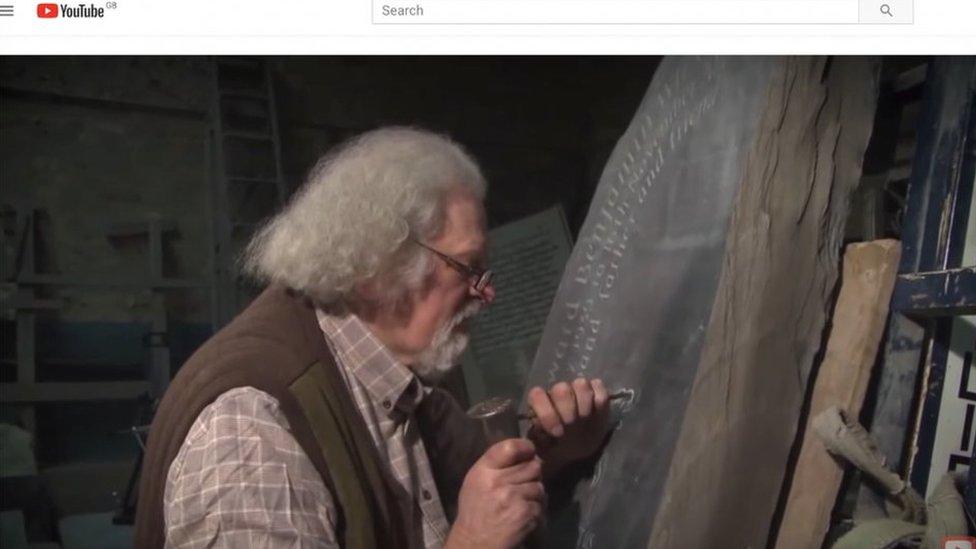ASMR: Stone carver Ieuan Rees is unwitting YouTube hit
- Published
Ieuan Rees, stone carver and unintentional ASMR star
A Welsh stone carver has become an unwitting YouTube star in videos which have attracted millions of hits from fans of ASMR.
ASMR (autonomous sensory meridian response) is a static, tingling sensation triggered by certain sounds, with online videos eliciting the so-called "braingasm" becoming hugely popular in recent years.
Veteran carver Ieuan Rees, 78, recorded a video to show off his craft in 2012 and "forgot all about it".
But years later he was shocked to discover the footage had been viewed 2.2 million times on YouTube, with fans hailing him an "inspiration".
"They love the combination of the sound of my voice, what I had to say from my heart and the sound of the chisel on the slate," Ieuan said.
"That whole combination seems to heal some people. God, it's embarrassing!"
The footage - originally shot by a production company which showcases arts and crafts - features Ieuan rhythmically carving on a tombstone while talking about his trade, teaching and philosophies on life.
After it was posted on YouTube, unbeknown to Ieuan, the footage was re-cut by an editor who makes "unintentional ASMR" videos and went on to secure cult status.
"A lady from the New York Times sent me an email asking if she could arrange a date for her to ring me to discuss this video, which apparently has had a huge following and it was a total surprise to me in every kind of way," he said.
Fans of the video have described Ieuan, of Ammanford, Carmarthenshire, as a "legend", a "wise elder" and "genuinely charming".
One viewer compares him to American painter and TV host, Bob Ross, while another posts: "OK YouTube, you win this round. I'm in."
"I'm not quite sure how to respond to it," Ieuan added.

What is ASMR?

The term is believed to have been coined by American Jennifer Allen, who started a Facebook group on the topic in 2010.
It is said to be a physical sensation in response to specific sights and sounds.
It has been described as the tingles generated by the videos, a frisson that travels from the top of the head down the spine and can be caused by numerous different triggers.
There are more than 13 million ASMR videos on YouTube including subjects such as people having haircuts, massages and towel-folding tutorials.

Agnieszka Janik McErlean, a senior lecturer in psychology at Bath Spa University, said the video was typical of footage or first-hand experiences which prompt ASMR.
"Typical triggers include whispering, crisp sounds, personal attention but also watching people perform very slow movements, being highly focused and engaged in performing a particular task."
She added: "People also watch videos in order to not only experience the tingling sensation, but also to relax to reduce stress and anxiety and to fall sleep."
Ieuan, a father-of-two, put his online success down to the combination of his "Welsh lilt", the "melodious, wonderful sound of carving" and his "talking from the heart".
His new-found fame online has come after a long and varied career of producing high-profile works in calligraphy and stone carving.

The video featuring Ieuan Rees was originally shot by Artisan Media
He designed the logo for the opening titles of TV comedy, the Vicar of Dibley, numerous memorials such as that for Lord Olivier at Westminster Abbey, and various commissions for work on public buildings, including the Senedd in Cardiff.
But he has also created thousands of headstones, which he says helped him to become a soothing and selfless communicator.
"When people are suffering from bereavement, especially if somebody has lost a little child, I have to handle that with all the delicacy that I have and try and make the parents feel that I'm doing something for them, so I don't care about myself," he added.
And while Ieuan says that, like many artists, he has always had an "inferiority complex", the latest reaction to his work has helped.
"It is an embarrassment but if I have been blessed with a talent and it gives pleasure to people then perhaps I should be humble enough and accept that and be grateful that I can do this."
- Published23 April 2019
- Published16 March 2019

- Published16 December 2015

- Published3 December 2018
